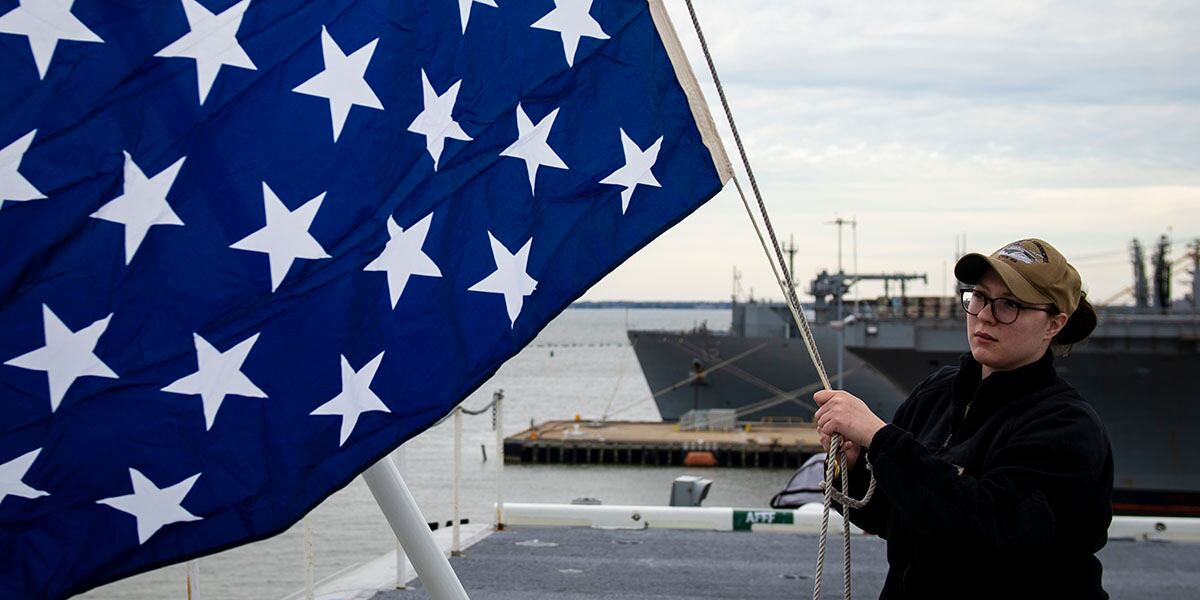NORFOLK — For the first time in nearly 17 years, the Navy’s commissioned ships worldwide hoisted on their bows the star-spangled Union Jack during Tuesday’s morning colors.
It was a moment of profound symbolism, pointing both to the Navy’s heroic past and a potentially violent future.
Tuesday marked the 77th anniversary of the Battle of Midway, a key strategic victory for the United States against Imperial Japan during World War II — and it was the Union Jack that fluttered in ports during the island hopping campaign.
But its rebirth on warships also has much to do with a call by Chief of Naval Operations Adm. John Richardson to focus on combat at sea against peer and near-peer competitors after nearly two decades of waging war against insurgencies and terrorist networks in the Middle East, Africa and Asia.
RELATED

All that was announced on Feb. 21 by a fleet-wide message ordering the Union Jack to replace the First Navy Jack on shipboard jackstaffs.
Famous for its “Don’t Tread on Me” rattlesnake slithering across 13 red and white stripes, the First Navy Jack had fluttered on all Navy ships since Sept. 11, 2002, the first anniversary of the terror attacks in the United States by al-Qaida.
Then-Secretary of the Navy Gordon England assumed it would continue to fly until the so-called Global War on Terrorism ended, but in his message to the fleet CNO Richardson argued that the Union Jack better reflected the cumulative strength of the nation and its Navy “where the whole is greater than the sum of its parts.”
The “rattlesnake jack” isn’t going away, however. It will be proudly flown on the Japan-based 7th Fleet flagship Blue Ridge, marking it as the oldest commissioned vessel in the active fleet.
It also survives as a shoulder patch worn on the Type III Navy Working Uniform.

The newest arrival to Naval Station Norfolk, the aircraft carrier John C. Stennis, put Richardson’s words into action on Tuesday.
“Today we raised the Union Jack on our ship,” said Lt. Nick Elliott, the flattop’s assistant navigator, after watching two of the warship’s quartermaster’s execute colors at Norfolk’s Pier 14.
“This small flag’s 50 stars represent the unity of the United States and that’s especially significant, today, on the anniversary of the critically important victory at Midway — a battle we won because of not only our initiative, but our unity and single focus of purpose, traits that are just as important today as we refocus on a more global scale.”
Flanked by fellow Texan Quartermaster 3rd Class Danaril Mojet on board Stennis, Quartermaster 2nd Class Matthew Lewis told Navy Times that both petty officers felt honored to raise the Union Jack on Tuesday.
“We wanted to get this right, so we took our time and and stayed focused on what we needed to do and did it right," said Lewis, a Dallas native.
Mark D. Faram is a former reporter for Navy Times. He was a senior writer covering personnel, cultural and historical issues. A nine-year active duty Navy veteran, Faram served from 1978 to 1987 as a Navy Diver and photographer.





